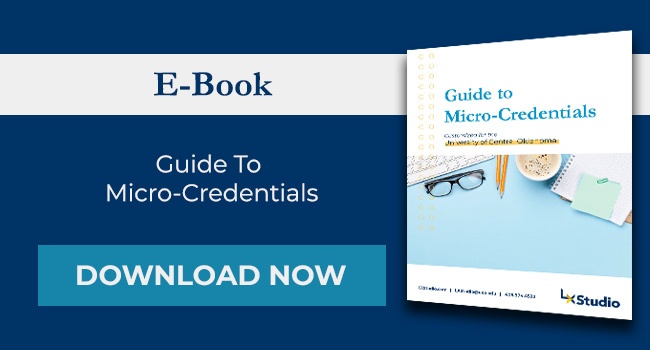
Three Techniques for Using Micro-Credentials to Engage Learners
Think of a time when you completed a college course, a webinar, or a workplace seminar…
There were most likely records of your attendance and completion…but…how were you able to communicate the skills you gained with others?
Did you receive a paper certificate? A standard transcript?
Micro-credentials are gaining popularity in education and workplace settings as a promising strategy for helping people demonstrate their knowledge, skills, and abilities to others.
What are micro-credentials?
There is some level of confusion around the definition of a micro-credential.
Micro-credentials are becoming more common as a method for helping people demonstrate their knowledge, skills, and abilities in new and more visible ways. Digital Promise defines micro-credentials as “digital certifications that verify an individual’s competency in a specific skill or set of skills.”
One of the more popular methods of issuing micro-credentials is through digital badges. A digital badge is an electronic representation of achievement from a pre-defined set knowledge, skills, or abilities.
Digital badges can be posted on social media platforms, linked on websites, or displayed on resumes. They provide a level of evidence that a person claiming they have a set of skills has demonstrated the claimed competencies in a verifiable way.
One note of particular importance is the distinction between curriculum and the micro-credential. A curriculum program or offering is primarily concerned with helping people build their knowledge, skills, and abilities. This can be accomplished through classes, workshops, readings, webinars, or any other type of instructional strategy.
In contrast, a micro-credential is primarily focused on verifying and communicating the achievement of knowledge, skills, and abilities independent of how they may have been acquired. This allows micro-credentials to be a strong signal for verifying that a person does indeed possess the competencies they are claiming.
Engaging Learners Using Micro-Credentials
Micro-credentials present an important opportunity to enhance engagement as part of an overall learning strategy.
The following list describes three options for using micro-credentials to support engagement.
Recognize Learning Milestones
Learning is an ongoing process that can take on many formal and informal paths. Micro-credentials allow learners to recognize key milestones along a learning journey.
Take earning a college degree, for example. This process can take many years with relatively few opportunities for recognition of skills along the way. Micro-credentials can help learners demonstrate and recognize their achievements as they are earned instead of when the overall degree is awarded.
This enhances motivation and increases opportunities for the learner to benefit from investments made throughout the education experience.
Create Positive Challenges
Micro-credentials can provide learners a positive challenge, or goal, to pursue.
For learners who are motivated by pursuing clearly defined goals, micro-credentials can outline a pathway and create a positive sense of challenge to achieve a defined objective. A micro-credential can create a destination that highlights opportunities for growth and obstacles that can be overcome through learning and growth.
Build Capability “Stacks”
We grow our competencies and capabilities every day. When we learn a new skill, that skill augments our existing compliment of capabilities.
Micro-credentials allow people to visualize their unique combination of knowledge, skills, and abilities. Opportunities for future growth can also be identified by seeing how an existing set of knowledge, skills, and abilities, might be augmented through growing new capabilities. This allows us to “stack” our knowledge, skills, and abilities together to create a unique mosaic of competencies and capabilities.
Concluding Thoughts
Micro-credentials are emerging as a new way of recognizing learning achievement. With thoughtful planning and design, micro-credentials can be used to help people share their expertise with others as well as increase engagement in learning experiences.
For more information and help with creating your own micro-credential, download our Guide to Micro-Credentials.






